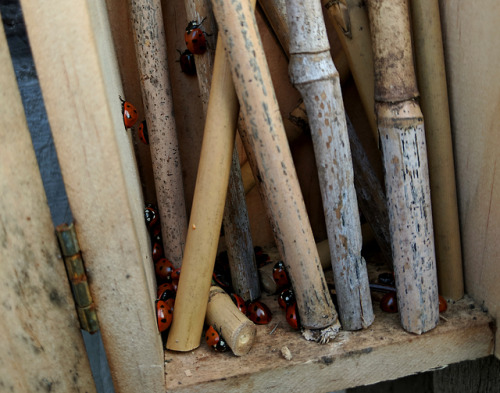#biological pest control
How I recruited a small army of ladybugs
In my last post, a reblog from last year, I mentioned the cut conifers to be sold as Christmas trees had started arriving at the garden centre where I work, but together with the trees we also received some visitors.
As of October, ladybugs (Coccinella septempunctata) begin congregating in sheltered places to spend their winter dormancy period, a time when their mobility and activity level are strictly dependant on the temperature, and it seems a large number of them had chosen the dense, evergreen foliage of the Nordmann firs (Abies nordmanniana) to do so. Whenever I would free a tree from its net, shaking it, several ladybugs (as well as a variety of spiders) would fall to the floor, suddenly thrown out of their cosy temporary home.
I collected and placed dozens of them around the garden centre, where they will be valuable allies in my battle against aphids next year, but I also decided to relocate some of them to my allotment. I had one of those boxes sold as “butterfly houses” installed on a south-facing portion of the fence, and I thought it could serve well for the purpose of giving them shelter, so I filled it with some bamboo sticks and placed them inside to see what they would do.
They seem to find it suitable, the following day the box was still full and the majority had climbed up to rest under the roof. If all goes well, they will spend the winter there, and when they emerge they will find the place to be a good breeding site, which will also, inexorably, be filled with food for them.
Aphids, mites and all of you, soft-bodied insects, cower before my army now!

Exactly two months after giving the ladybugs a new home, I gave a small group of them a first task. A Salvia plant overwintering in my mini greenhouse had become the target of likewise overwintering aphids, taking advantage of the sheltered position. I could have simply used an insecticidal spray, but why, when I can mingle with biological warfare?!
Jokes aside, any shelter or protective structure you can give a plant against the cold will also be ideal for other creatures. Biological pest control means playing with the balance in the numbers of these creatures, encouraging what’s beneficial to your situation.
Go ladybugs!
Post link
How I recruited a small army of ladybugs
In my last post, a reblog from last year, I mentioned the cut conifers to be sold as Christmas trees had started arriving at the garden centre where I work, but together with the trees we also received some visitors.
As of October, ladybugs (Coccinella septempunctata) begin congregating in sheltered places to spend their winter dormancy period, a time when their mobility and activity level are strictly dependant on the temperature, and it seems a large number of them had chosen the dense, evergreen foliage of the Nordmann firs (Abies nordmanniana) to do so. Whenever I would free a tree from its net, shaking it, several ladybugs (as well as a variety of spiders) would fall to the floor, suddenly thrown out of their cosy temporary home.
I collected and placed dozens of them around the garden centre, where they will be valuable allies in my battle against aphids next year, but I also decided to relocate some of them to my allotment. I had one of those boxes sold as “butterfly houses” installed on a south-facing portion of the fence, and I thought it could serve well for the purpose of giving them shelter, so I filled it with some bamboo sticks and placed them inside to see what they would do.
They seem to find it suitable, the following day the box was still full and the majority had climbed up to rest under the roof. If all goes well, they will spend the winter there, and when they emerge they will find the place to be a good breeding site, which will also, inexorably, be filled with food for them.
Aphids, mites and all of you, soft-bodied insects, cower before my army now!
Post link


